Betel nut
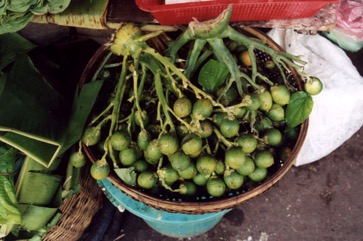
A tropical plant. They occur from sea level up to 900 m altitude in the tropics. It does best in rich moist soils in a shady, sheltered position. It needs soils of reasonable depth for good production. Plants are drought and frost tender. The seed needs to be sown when temperatures are 24-27°C. Plants can tolerate temperatures down to a minimum of 13-15°C. Found in settled areas throughout the Philippines. Also found in virgin forest in Palawan. It grows in Nepal up to 400 m altitude. In Cairns Botanical Gardens including var. alba. It suits hardiness zones 11-12. In Yunnan.
Also known as:
Adakka, Adike, Angiro, Areca nut, Betel, Bo, Bonga, Bu, Bua, Buai, Bunga, Buuch, Chambe, Fen-foah, Gaisa, Go-yu, Heta, Jambe, Jin si bao ta, Kasu, Kikiro fasia, Kove, Kunthi-pin, Maak, Malua, Mpopoo, Nga nga, Nokalua, Nyia nwotapi, Ota, Pakku, Pan, Pijaka, Pinang, Pinang sirih, Poc, Poogiphalam, Pu, Pua liki, Pua mouku, Pua, Puak, Pugua, Supari, Tamol, Vakka, Vua
Synonyms
- Areca cathecu Burman
- Areca faufel Gaertner
- Areca hortensis Loureiro
- Areca himalayana H. Wendland
- Areca nigra H. Wendland
Edible Portion
- Nuts, Cabbage, Palm heart, Male flowers
Where does Betel nut grow?
Found in: Africa, Andamans, Asia, Australia, Bangladesh, Bhutan, Bougainville, Cambodia, Cameroon, Caroline Islands, Central Africa, China, Cuba, Dominican Republic, East Africa, East Timor, Fiji, Grenada, Guam, Haiti, Hawaii, Himalayas, India, Indochina, Indonesia, Jamaica, Laos, Malaysia, Maldives, Mariana Islands, Marshall Islands, Mayotte, Micronesia, Myanmar, Nepal, Northeastern India, Pacific, Pakistan, Palau, Papua New Guinea, PNG, Philippines, Pohnpei, Puerto Rico, Samoa, SE Asia, Singapore, Solomon Islands, Sri Lanka, Suriname, Taiwan, Tanzania, Thailand, Timor-Leste, United States, Vietnam, West Africa, West Indies, West Papua, Yap
Notes: Seeds contain the alkaloid arecolaine and others alkaloids. There are 60 Areca species. They are tropical. The nuts can contain significant fluoride which is ingested while chewing.
Status: It occurs as an important social nut and masticatory in all lowland areas of many Asian and Pacific countries. It is traded into the highland regions.
Growing Betel nut
Cultivation: Trees are grown from seed. The seedlings are transplanted at 1-2 years of age. A spacing of 3 m between plants is the best spacing. Bananas can be used to provide temporary shade while betel nut palms get established. Holes 50 cm across and deep need to be dug. The seedlings should be planted 20 cm below ground level. As emerging prop roots develop the hole should be filled in.
Edible Uses: The nut is chewed (with lime and betel pepper) as a masticatory. The heart of the palm is edible and eaten raw or cooked. It is also used for pickles. The young fruit are used to tenderise meat. CAUTION Chewing betel nut is associated with cancer of the mouth and throat. It contains alkaloids and tannins.
Production: The palm commences bearing fruit after about 7 years. The fruit take 6-8 months to ripen. Trees can continue fruiting for 30-60 years.
Nutrition Info
per 100g edible portion| Edible Part | Energy (kcal) | Protein (g) | Iron (mg) | Vitamin A (ug) | Vitamin c (mg) | Zinc (mg) | % Water |
|---|---|---|---|---|---|---|---|
| Nuts | 399 | 4.4 | 4.2 | 0 | 0 | - | 10.8 |
| Palm heart | - | - | - | - | - | - |
Betel nut Photos

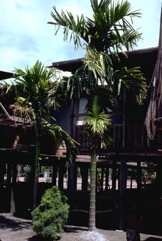
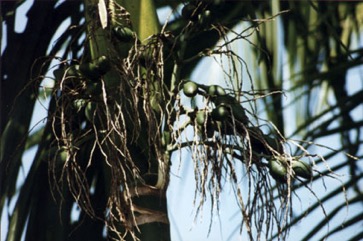
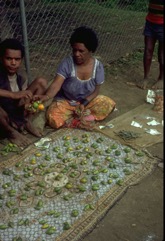
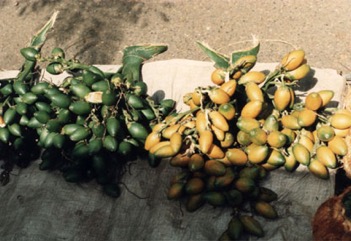
References
Ali, A. M. S., 2005, Homegardens in Smallholder Farming Systems: Examples from Bangladesh. Human Ecology, Vol. 33, No. 2 pp. 245-270
Ambasta S.P. (Ed.), 2000, The Useful Plants of India. CSIR India. p 50
Awasthi, A.K., 1991, Ethnobotanical studies of the Negrito Islanders of Andaman Islands, India - The Great Andamanese. Economic Botany 45(2) pp274-280
Baker, W.J. and Dransfield, J., 2006, Field Guide to Palms of New Guinea. Kew p 53
Balick, M.J. and Beck, H.T., (Ed.), 1990, Useful palms of the World. A Synoptic Bibliography. Colombia p 74, 121, 447,
Bandyopadhyay, S. et al, 2009, Wild edible plants of Koch Bihar district, West Bengal. Natural Products Radiance 8(1) 64-72
Barfod, A.S., Banka R., and Dowe, J. L., 2001, Field Guide to Palms in Papua New Guinea. AAU Reports 40 Department of Systematic Botany University of Aarhus. Denmark. p 56
Batet, K., Koil, U., and Hertel, H., 1998, Traditional Plant Use by the Didipa Clan, Baitabag, Papua New Guinea. GDS. p 23
Bircher, A. G. & Bircher, W. H., 2000, Encyclopedia of Fruit Trees and Edible Flowering Plants in Egypt and the Subtropics. AUC Press. p 40
Blomberry, A. & Rodd, T., 1982, Palms. An informative practical guide. Angus & Robertson. p 51
Bodkin, F., 1991, Encyclopedia Botanica. Cornstalk publishing, p 98
Borrell, O.W., 1989, An Annotated Checklist of the Flora of Kairiru Island, New Guinea. Marcellin College, Victoria Australia. p 35
Bremness, L., 1994, Herbs. Collins Eyewitness Handbooks. Harper Collins. p 37
Brickell, C. (Ed.), 1999, The Royal Horticultural Society A-Z Encyclopedia of Garden Plants. Convent Garden Books. p 133
Brouk, B., 1975, Plants Consumed by Man. Academic Press, London. p 373
Brown, D., 2002, The Royal Horticultural Society encyclopedia of Herbs and their uses. DK Books. p 128
Burkill, H. M., 1985, The useful plants of west tropical Africa, Vol. 4. Kew.
Burkill, I.H., 1966, A Dictionary of the Economic Products of the Malay Peninsula. Ministry of Agriculture and Cooperatives, Kuala Lumpur, Malaysia. Vol 1 (A-H) p 223
Castillo, C., 2013, The Archaeobotany of Khao Sam Kaeo and Phu Khao Thong: The Agriculture of Late Prehistoric Southern Thailand. Ph. D. thesis University College, London
Chowdery, T., et al, 2014, Wild edible plants of Uttar Dinajpur District, West Bengal. Life Science Leaflets. 47:pp 20-36 http://lifesciencesleaflets.ning.com
Clarke, W.C. & Thaman, R.R., 1993, Agroforestry in the Pacific Islands: Systems for sustainability. United Nations University Press. New York. p 222
Cobley, L.S. (rev. Steele, W.M.) 2nd Ed., 1976, An Introduction to the Botany of Tropical Crops. Longmans. p 217
Cundall, P., (ed.), 2004, Gardening Australia: flora: the gardener's bible. ABC Books. p 180
Elevitch, C.R.(ed.), 2006, Traditional Trees of the Pacific Islands: Their Culture, Environment and Use. Permanent Agriculture Resources, Holualoa, Hawaii. p 69
Etherington, K., & Imwold, D., (Eds), 2001, Botanica's Trees & Shrubs. The illustrated A-Z of over 8500 trees and shrubs. Random House, Australia. p 103
Ethnobotany of Karbis. Chapter 4 in p 107
Evans, B. R, 1999, Edible nut Trees in Solomon Islands. A variety collection of Canarium, Terminalia and Barringtonia. ACIAR Technical Report No. 44 96pp
Facciola, S., 1998, Cornucopia 2: a Source Book of Edible Plants. Kampong Publications, p 26
Farnworth, E.R., 1976, Betel Nut- Its Composition, Chemistry and Uses, Science in New Guinea 4 (2): 85-90
Flora of Pakistan. www.eFloras.org
French, B., 1986, Food Plants of Papua New Guinea, Asia Pacific Science Foundation p 157
French, B.R., 2010, Food Plants of Solomon Islands. A Compendium. Food Plants International Inc. p 274
Friday, J. B., 2005, Forestry and Agroforestry Trees of East Timor. http://www.ctahr.hawaii.edu/forestry/data/Timor/Timor trees.html
Furusawa, T., et al, 2014, Interaction between forest biodiversity and people's used of forest resources in Roviana, Solomon Islands: implications for biocultural conservation under socioeconomic changes. Journal of Ethnobiology and Ethnomedicine, 10:10
Gibbons, M., 1993, Palms. Compact study Guide and Identifier. Sandstone. p 17
Hani Medicine of Xishuangbanna, 1999, p 471
Hariyadi, B., 2008, The Entwined Tree: Traditional Natural Resource Management of Serampas, Jambi, Indonesia. Ph. D thesis. Univ. or Hawaii. p 444
Haynes, J., & McLaughlin, J., 2000, Edible palms and Their Uses. University of Florida Fact sheet MCDE-00-50-1 p 2
Hedrick, U.P., 1919, (Ed.), Sturtevant's edible plants of the world. p 70
Henderson, C.P. and I.R.Hancock, 1988, A Guide to the Useful Plants of the Solomon Islands. Res. Dept. Min of Ag. & Lands. Honiara, Solomon Islands. p 144
Henty, E.E., 1980, Harmful Plants in Papua New Guinea. Botany Bulletin No 12. Division Botany, Lae, Papua New Guinea. p 114
Hibbert, M., 2002, The Aussie Plant Finder 2002, Florilegium. p 32
Hu, Shiu-ying, 2005, Food Plants of China. The Chinese University Press. p 300
Jacquat, C., 1990, Plants from the Markets of Thailand. D.K. Book House p 106
Janick, J. & Paul, R. E. (Eds.), 2008, The Encyclopedia of Fruit & Nuts. CABI p 86
Johnson, D.V., 1998, Tropical palms. Non-wood Forest products 10. FAO Rome. p 125
Jones, D.L., 1994, Palms throughout the World. Smithtonian Institution, Washington. p 56, 57
Jones, D.L., 2000, Palms of Australia 3rd edition. Reed/New Holland. p 115
Kiple, K.F. & Ornelas, K.C., (eds), 2000, The Cambridge World History of Food. CUP p 1891
Kumar, S. A., Manus, D. & Mallika, M., 2018, Impact of non-timber forest products on Forest and in Livelihood Economy of the People of Adjoining Areas of Jalpaiguri Forest Division, West Bengal, India. Int. J. of Life Sciences, 2018; 6 (2):365-385
Kuo, W. H. J., (Ed.) Taiwan's Ethnobotanical Database (1900-2000), http://tk.agron.ntu.edu.tw/ethnobot/DB1.htm
Lepofsky, D., 1992, Arboriculture in the Mussau Islands, Bismarck Archipelago. Economic Botany, Vol 46, No. 2, pp. 192-211
Liu, Yi-tao, & Long, Chun-Lin, 2002, Studies on Edible Flowers Consumed by Ethnic Groups in Yunnan. Acta Botanica Yunnanica. 24(1):41-56
Llamas, K.A., 2003, Tropical Flowering Plants. Timber Press. p 92
Lord, E.E., & Willis, J.H., 1999, Shrubs and Trees for Australian gardens. Lothian. p 92
Manandhar, N.P., 2002, Plants and People of Nepal. Timber Press. Portland, Oregon. p 94
Martin, F.W. & Ruberte, R.M., 1979, Edible Leaves of the Tropics. Antillian College Press, Mayaguez, Puerto Rico. p 209
Martin, F. W., et al, 1987, Perennial Edible Fruits of the Tropics. USDA Handbook 642 p 46
Monsalud, M.R., Tongacan, A.L., Lopez, F.R., & Lagrimas, M.Q., 1966, Edible Wild Plants in Philippine Forests. Philippine Journal of Science. p 516
Murtem, G. & Chaudhrey, P., 2016, An ethnobotanical note on wild edible plants of Upper Eastern Himalaya, India. Brazilian Journal of Biological Sciences, 2016, v. 3, no. 5, p. 63-81
Ochse, J. J. et al, 1931, Vegetables of the Dutch East Indies. Asher reprint. p 551
Ong, H., et al, 2012, Traditional knowledge and usage of edible plants among the Semai community of Kampung Batu 16, Tapah, Perak, Malaysia. Scientific Research and Essays Vol. 7(4), pp. 441-445, 30 January, 2012
Peekel, P.G., 1984, (Translation E.E.Henty), Flora of the Bismarck Archipelago for Naturalists, Division of Botany, Lae, PNG. p 62, 60
Phon, P., 2000, Plants used in Cambodia. © Pauline Dy Phon, Phnom Penh, Cambodia. p 48
Plants of Haiti Smithsonian Institute http://botany.si.edu
Purseglove, J.W., 1972, Tropical Crops. Monocotyledons. Longmans p 434
Rashid, H. E., 1977, Geography of Bangladesh. Westview. p 323
Riffle, R.L. & Craft, P., 2003, An Encyclopedia of Cultivated Palms. Timber Press. p 30, 253
Sahni, K.C., 2000, The Book of Indian Trees. Bombay Natural History Society. Oxford. p 184
Schuler, S., (Ed.), 1977, Simon & Schuster's Guide to Trees. Simon & Schuster. No. 47
Selvam, V., 2007, Trees and shrubs of the Maldives. RAP Publication No. 2007/12 p 208
Smith, P.M., 1979, Betel Nut, in Simmonds, N.W., (ed), Crop Plant Evolution. Longmans. London. p 318
Sp. pl. 2:1189. 1753 "cathecu"
Staples, G.W. and Herbst, D.R., 2005, A tropical Garden Flora. Bishop Museum Press, Honolulu, Hawaii. p 618
Sujanapal, P., & Sankaran, K. V., 2016, Common Plants of Maldives. FAO & Kerala FRI, p 40
Sukarya, D. G., (Ed.) 2013, 3,500 Plant Species of the Botanic Gardens of Indonesia. LIPI p 749
Teron, R. & Borthakur, S. K., 2016, Edible Medicines: An Exploration of Medicinal Plants in Dietary Practices of Karbi Tribal Population of Assam, Northeast India. In Mondal, N. & Sen, J.(Ed.) Nutrition and Health among tribal populations of India. p 149
Terra, G.J.A., 1973, Tropical Vegetables. Communication 54e Royal Tropical Institute, Amsterdam, p 25
United Nations University. Appendix One hundred Pacific Island agroforestry trees (2)
Vander Velde, N, 2003, The Vascular Plants of Majuro Atoll, Republic of the Marshall Islands. Atoll research Bulletin. No. 503. Smithsonian Institute. p 31
Vivien, J., & Faure, J.J., 1996, Fruitiers Sauvages d'Afrique. Especes du Cameroun. CTA p 74
Wahyudi, 2017, Non-timber Forest Product (NTFP) Commodities Harvested and Marketed by Local People at the Local Markets in Manokwari - West Papua. Indonesian Journal of Forestry Research Vol. 4, No. 1, 27-35
Watling, D., 2005, Palms of the Fiji Islands. Environmental Consultants (Fiji) Ltd. p 153
Wickens, G.E., 1995, Edible Nuts. FAO Non-wood forest products. FAO, Rome. p162
Williams, C.N., Chew, W.Y., and Rajartnam, J.A., 1989, Tree and Field Crops of the Wetter Regions of the Tropics. Longman, p 76
Wong, M., 2006, Edible Plants for Hawai'i Landscapes. College of Tropical Agriculture and Human Resources. Univ. of Hawai'i
World Checklist of Useful Plant Species 2020. Royal Botanic Gardens, Kew
www.ethnobiomed.com
www.worldagroforestrycentre.org/sea/products/afdbases/af/asp/SpeciesInfo.asp?SpID=233
Yeshi, K. et al, 2017, Taxonomical Identification of Himalayan Edible Medicinal Plants in Bhutan and the Phenolic Contents and Antioxidant Activity of Selected Plants. TBAP 7 (2) 2017 pp 89 - 106